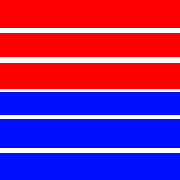Imagine you have the two fractions $$\dfrac{-3}{4}$$ and $$\dfrac{6}{-8}$$ and we apply it to an integer, $$32$$ for instance, and we get the same result:
$$$(32:4)\cdot(-3)=8\cdot(-3)=-24$$$ $$$(32:(-8))\cdot6=-4\cdot6=-24$$$
In this case, we can say that $$\dfrac{-3}{4}$$ and $$\dfrac{6}{-8}$$ are equivalent fractions.
In this example, we can check that if we multiply the numerator of the first fraction by the denominator of the second, the result is the same as if we multiply the denominator of the first fraction by the second numerator: $$$-3\cdot(-8)=4\cdot6$$$
In general, we say that two fractions $$\dfrac{a}{b}$$ and $$\dfrac{c}{d}$$, with $$b\neq0$$ and $$c\neq0$$, are equivalent if: $$$a\cdot d=b\cdot c$$$
To express it we write down: $$\dfrac{a}{b} \backsim \dfrac{c}{d}$$ or $$\dfrac{a}{b}=\dfrac{c}{d}.$$
The relation "be equivalent to" has the following properties:
Reflexive property
Every fraction is equivalent to itself, $$\dfrac{a}{b}=\dfrac{a}{b}$$ because $$a\cdot b=a\cdot b$$.
Symmetric property
If $$\dfrac{a}{b}$$ is equivalent to $$\dfrac{c}{d}$$, then the fraction $$\dfrac{c}{d}$$ is equivalent to $$\dfrac{a}{b}$$.
If $$\dfrac{a}{b}=\dfrac{c}{d}$$ means that $$a\cdot d=b \cdot c$$, then $$c \cdot b=d\cdot a$$ that means $$\dfrac{c}{d}=\dfrac{a}{b}$$.
Transitive property
If one fraction is equivalent to another, and this last one is equivalent to a third fraction, then the first one is equivalent to the third one:
$$$\left.\begin{array}{c} \dfrac{a}{b} & = & \frac{c}{d} \\ \frac{c}{d} & = & \frac{n}{m} \end{array}\right\} \ \mbox{then} \ \dfrac{a}{b}=\dfrac{n}{m} $$$
The equivalence between fractions is an equivalence relation that classifies the fractions into classes of equivalent fractions.
A class of equivalent fractions is a set of fractions where all of them are equivalent, and any other fraction which isn't into the set is not equivalent to any of them.
Every class of equivalence is a rational number.
Obtain equivalent fractions
Consider the fraction $$\dfrac{a}{b}$$ and an integer $$m$$ nonzero.
If we multiply the numerator and denominator of the fraction $$\dfrac{a}{b}$$ by $$m$$ the result is: $$$\dfrac{a\cdot m}{b\cdot m}$$$
This new fraction is equivalent to $$\dfrac{a}{b}$$, ie: $$$\dfrac{a\cdot m}{b\cdot m}=\dfrac{a}{b}$$$ due to: $$$(a\cdot m)\cdot b= a \cdot (b \cdot m)$$$
Consider the fraction $$\dfrac{1}{2}$$, graphically

Is

If we multiply the numerator and denominator of the fraction by $$m=3$$, we obtain: $$\dfrac{1}{2}=\dfrac{1\cdot3}{2\cdot3}=\dfrac{3}{6}$$, that graphically is

The painted parts are the same, so the fractions are equivalent!
A very important case of equivalent fractions appears when we have negative denominators, because if we want to interpret the fraction as an integer division, having a negative divisor makes it very difficult, so if we multiply numerator and denominator by $$-1$$ then we obtain an equivalent fraction with positive denominator, and therefore much easier to operate.
If we want to calculate $$\dfrac{5}{-7}$$ of $$49$$, we can do $$$(49:(-7))\cdot5$$$ which is not an easy calculation. However, the fraction $$$\dfrac{5\cdot(-1)}{-7\cdot(-1)}=\dfrac{-5}{7}$$$ is equivalent to the first one, and it is more efficient: $$$(49:7)\cdot(-5)=7\cdot(-5)=-35$$$
On the other hand, the fraction $$$\dfrac{5\cdot(-7)}{-7\cdot(-7)}=\dfrac{-35}{49}$$$ is also equivalent to the last one, and the calculation is much easier: $$$(49:49)\cdot(-35)=1\cdot(-35)=-35$$$
Consider now the fraction $$\dfrac{-10}{20}$$ and $$\dfrac{-2}{4}$$. They are equivalent: $$$-10\cdot 4=20\cdot(-2)$$$ We can say that we have obtained the first one from the second one multiplying numerator and denominator by $$m=5$$, or we can say that we have done it dividing by $$m=5$$ the numerator and denominator of the first fraction. In this last case, we say we have simplified the fraction $$\dfrac{-10}{20}$$ a $$\dfrac{-2}{4}$$.
To simplify a fraction means to divide numerator and denominator by the same integer.
The fraction $$\dfrac{4}{12}$$ can be simplified dividing numerator and denominator by $$2$$.
$$$\dfrac{4:2}{12:2}=\dfrac{2}{6}$$$ The obtained fraction is equivalent to the first one: $$$4\cdot6=12\cdot2$$$ And, ¿it is possible to simplify it again? The answer is yes, for example, we can divide numerator and denominator by two:
$$$\dfrac{2:2}{6:2}=\dfrac{1}{3}$$$
And now, ¿is it possible to simplify it again? And the answer is no, because there is no integer that divides $$1$$ and $$3$$ at the same time.
Those fractions that can not be simplified are called irreducible.
Formally, we say that a fraction $$\dfrac{a}{b}$$ is irreducible if the numerator and denominator are coprime, ie, $$m.c.d(a,b)=1.$$
If we have these fractions $$\dfrac{3}{4}$$ and $$\dfrac{2}{-5}$$, they can not be simplified because $$2$$, $$3$$ and $$5$$ are prime numbers.
Thus, to find an equivalent fraction to another one that would be irreducible, we must simplify using the greatest common divisor.
Suppose we have this fraction $$\dfrac{4}{12}$$. To simplify it we must do:
- Calculate the greatest common divisor of numerator and denominator. In our example, $$4=2^2$$ and $$12=2^2\cdot3$$, so $$$g.c.d(4,12)=2^2=4$$$
- Divide numerator and denominator by their gcd:$$$\dfrac{4:4}{12:4}=\dfrac{1}{3}$$$
This new fraction is equivalent: $$$4\cdot3=12\cdot1$$$
Graphically
And it is irreducible: $$g.c.d(1,3)=1$$.
Two irreducible and different fractions will never be equivalent, and for this reason every one will be in a different representation class.
Thus, if we want to make a reference for a class we must use the irreducible fraction, and we will call it the class representative.

